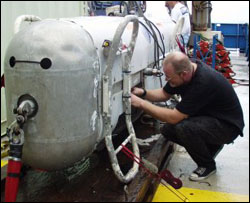
DSL-120
Looking vaguely like an 11 foot, 6 inch long grey candybar, DSL-120 will be the first submersible vehicle to go in the water. Its grey cover encloses equipment that emits sound frequencies of 120,000 cycles per second, hence its name.
Fig. 1. Woods Hole Deep Submergence Laboratory engineer, Jim Varnam, working on the DSL-120 vehicle equipped with side-scan sonars. Photo by Monte Basgall.
While DSL-120 is itself neutrally buoyant, an attached weight will make it sink after being raised from Atlantis's aft deck by a crane and lowered into the water. The vehicle will remain linked to its mother ship at all times by a 6/10 inch-thick cable made up of copper, steel, and fiber-optic fibers. The steel keeps the link from breaking, the copper conducts electric power, and the fiber-optics provide the communications.
Nicknamed "the fish," as are all towed submersibles, DSL-120 will be pulled by Atlantis at about 1 knot while an operator in the control room on an upper aft deck of Atlantis reels out just enough cable to keep it "flying" about 75 to 100 meters over underwater terrains.
Link: DSL-120
For more information on the DSL-120, check out the Woods Hole Oceanographic Institution page: http://www.whoi.edu/home/marine/dsl120_main.html
Scientists will stand control room watches whenever this fish is in the water to monitor its reflected pulses, which are recorded on a constantly feeding paper role as well as on magnetic tape and on a false-color video monitor. While providing the most details, the magnetic tape requires follow-up processing. The dry paper tape offers the best quick results, so it becomes the center of attention in the control room.
Several researchers may cluster there at once, pondering, discussing or debating the significance of the ghostly images, which are brightest where reflectivity is highest, such as from heaps of broken rock. The dullest returns are from the most sound absorbent materials, such as mud.
While the results are relatively crude, the DSL-120 sonar scans provide a general idea of the terrain's geology. It also helps scientists decide where to send Argo-II, a picture taking and videotaping submersible.
To learn more about the vehicles:
DSL-120 | Argo II | Alvin

|

|
|








